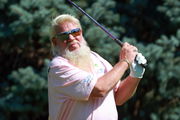
Imago
June 13, 2023, Los Angeles, California, USA: Golfers Phil Mickelson right and Jon Rahm left watch a member of their foursome s ball during a practice round for the 2023 US Open on June 14 at the Los Angeles Country Club. News – June 13, 2023 PUBLICATIONxINxGERxSUIxAUTxONLY – ZUMAh234 20230613_zsp_h234_023 Copyright: xMarkxEdwardxHarrisx

Imago
June 13, 2023, Los Angeles, California, USA: Golfers Phil Mickelson right and Jon Rahm left watch a member of their foursome s ball during a practice round for the 2023 US Open on June 14 at the Los Angeles Country Club. News – June 13, 2023 PUBLICATIONxINxGERxSUIxAUTxONLY – ZUMAh234 20230613_zsp_h234_023 Copyright: xMarkxEdwardxHarrisx
Golf prides itself on tradition. This game has been played for centuries with rituals, etiquette, and rulebooks that might run thousands of pages. But inside those rules, there are sometimes regulations that are real head-scratchers, so oddly specific you can’t help but wonder what might have caused them to come about. But in actuality, most of them are not relics of the past. They are still alive and well, and they keep quietly shaping how professionals navigate the courses. Here’s a look at some of the most bizarre golf rules that still exist today.
Watch What’s Trending Now!
Top Stories
PGA Tour Pros React Strongly as Brooks Koepka Breaks $100M LIV Golf Contract: ‘I Vote..’

John Daly Calls Out PGA Tour Over Gap LIV Golf Has Already Closed

5 Biggest Names Not Returning to LIV Golf in 2026

Brooks Koepka’s Wife Jena Sims Shares ‘Major Debate’ at Home Hours After His LIV Exit

John Daly Shares Harsh Reality of His Health as He Admits His ‘Career Is Declining’

1. The cactus rule
If you have ever watched golf in the Arizona desert, you might have probably wondered: what happens if a ball ends up near a cactus? Well, there is, of course, a rule for that. Under Clarification 10.2(5)/2, you can wrap a towel around yourself for protection while you take a shot. But you can’t put anything on the cactus itself. Seems fair, right?
ADVERTISEMENT
The problem is, almost no one remembers this when it actually happens. In 2014, Kevin Stadler‘s tee shot found its way into a cholla cactus at the Waste Management Phoenix Open. The ball was stuck between spines, a few inches above the ground. Instead of attempting the entire towel-wrapping technique, Stadler just declared it lost and took the penalty. What followed was a double bogey.
Only if you could have used a towel, Kevin.
ADVERTISEMENT
2. When animals get involved
Golf courses are spread far and wide, with multiple hazards scattered throughout them. They often double as wildlife sanctuaries due to this. So naturally, there are chances of animals frolicking around on the green. And as you might have already guessed, there have been instances of this happening in the past. Of course, there are rules for such situations as well.
Rule 9.6 covers a ball moved by an “outside influence.” What it means is, if your ball is resting and let’s suppose a bird, a fox, or a notorious squirrel moves it accidentally, there will be no penalty. You can just replace the ball where it was and continue the play. This happened with Phil Mickelson at Pebble Beach.
ADVERTISEMENT
During the 2019 US Open, a seagull pecked at his golf ball and moved it from its place! Mickelson, then confused, called the officials, and after discussion, replaced the ball to sink a 27-foot birdie putt! Classic Lefty.
Phil Mickelson has made 4 birdies and 1 seagull. #USOpen pic.twitter.com/5gIJ1e1aE4
— U.S. Open (@usopengolf) June 14, 2019
There are also protections from dangerous animals under Rule 16.2b. If, let’s say, an alligator, a poisonous snake, or even a mound of fire ants is close enough to put you at risk (these can happen if you are playing in Florida!), you are entitled to a free relief. Then there are burrowing animals, which have their own carve-out.
ADVERTISEMENT
Rule 16.1b treats animal holes as “abnormal course conditions.” So if your ball ends up in or on a gopher hole, you can take a free drop at the nearest point of relief. But it gets quirky here; it’s golf after all. This does not extend to other animal damage. So like, if a deer tramples the fairway or a dog digs up a patch of rough, that’s just “tough luck” for you. You will be forced to play it as it lies. It’s interesting and almost funny how this rule makes a hard distinction between burrowing and non-burrowing creatures.
3. Headphones and music
This rule is where things get almost comically subjective. Rule 4.3(4) says you can listen to music during a round if it’s just for entertainment. But if you are using it to block out distractions or, worse, to help with swing tempo (seriously, who even thought of this?), that’s a penalty. The first offense: two strokes; the second offense is straight-up disqualification! Ouch.
ADVERTISEMENT
Picture this: You are vibing to Led Zeppelin, and for some out-of-universe reason, the beat lines up perfectly with your putting stroke. Yeah, that is illegal. Now the question is, how on earth does anyone prove the intent? Are officials supposed to read your mind mid-round? So here is the thing. The officials would expect you to turn yourself in if you break this rule. In other words, this rule relies on the honesty and integrity of the players. As of now, no big-name pro has been penalized under this rule…yet (you can never be too sure in golf).
On the Tour, headphones are fine during practice rounds but must disappear once competition starts. LIV Golf has sidestepped the issue entirely by blasting music over loudspeakers at events, and since it’s environmental and not player-controlled, it doesn’t break the rules.
ADVERTISEMENT
4. The 14-Club Limit
This might be the most well-known rule on the list, but that does not deflect from how absurd it is. Rule 4.1b(1) says you can’t carry more than 14 clubs in your bag. It doesn’t matter if you use them or not. Just having an extra lurking in your bag is enough to rack up a penalty. Two strokes per hole, max of four per round!
Joel Dahmen found this out the hard way at the 2024 Shrines Children’s Open. He accidentally started with 15 clubs, including two 4-irons. The penalty turned his 72 into a 76, tanking his chances and eventually leading him to withdraw. “Never happened to me before,” he said after the incident. “I travel with 15, 16 clubs. I think most people out here do, depending on conditions and courses. You know, I’ve been traveling out here for a long time, and it has never happened before.”
On the LPGA Tour, Minjee Lee did something similar the same year at the ANNIKA LPGA. She realized she had a training aid club still in her bag. But it was too late by that time, and she got a two-stroke penalty. But Minjee Lee, being Minjee Lee, easily recovered from that and salvaged her round by shooting a 69.
ADVERTISEMENT
But the most famous blunder belongs to Ian Woosnam at the 2001 Open Championship. After birdieing the first hole to tie for the lead, he discovered he had an extra driver in his bag. The two-stroke penalty, unfortunately, shattered his momentum, and he finished four shots behind David Duval, the ultimate winner. Brutal.
5. The orange rule
And finally, the most delightfully specific rule of them all. Apparently, the far-sighted rules officials carved out a scenario where your golf ball got stuck in an orange! According to USGA Decision 23/10, if this does happen, you will be out of luck. You can either hit the ball as it lies—in the orange—or declare it unplayable and take a one-stroke penalty. Of course, no known incidents involving this rule have happened yet.
ADVERTISEMENT
Now tell me, why does golf have a beef with orange? This rule dates back to courses built through citrus groves in California and Florida, where oranges, grapefruits, and lemons were as much a hazard as bunkers or water. Even today, if you play at a course like Cabot Citrus Farms in Florida, the orange rule technically applies.
On paper, some of these rules sound silly. But they are all part of golf’s obsessive dedication to fairness. Every possible situation, no matter how rare, has a protocol. That way, when something bizarre happens under tournament pressure, there’s a clear-cut answer—at least in theory.
ADVERTISEMENT
ADVERTISEMENT
ADVERTISEMENT

